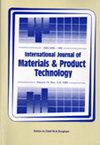光子多普勒测速法测量铜-钢管电磁脉冲焊接冲击速度
IF 0.3
4区 材料科学
Q4 MATERIALS SCIENCE, MULTIDISCIPLINARY
International Journal of Materials & Product Technology
Pub Date : 2021-06-21
DOI:10.1504/ijmpt.2021.115822
引用次数: 0
摘要
采用电磁脉冲焊接方法制造了铜-钢管接头,并用光子多普勒测速仪测量了接头的冲击速度。目标管的内径减小和剩余横截面积在焊接后确定。与没有内部支撑的配置相比,具有内部支撑的管对管配置显示出更大的剩余横截面积。此外,对于管-杆配置,撞击后的初始速度下降立即降至零,而对于管-管配置,发现速度下降到中间水平。速度和加速度随放电能量的增加而增加。加速度为正,至少达到9μs,预期转折点位于9μs和11μs之间。在1.0 mm和1.5 mm的间隔距离处,碰撞时加速度仍然为正,但在2.0 mm处可能为负。本文章由计算机程序翻译,如有差异,请以英文原文为准。
Photon Doppler velocimetry measurements of the impact velocity during electromagnetic pulse welding of copper-steel tubular joints
Tubular copper to steel joints were manufactured by electromagnetic pulse welding, during which the impact velocity was measured with photon Doppler velocimetry. The reduction in inner diameter and the remaining cross-sectional area of the target tube were determined after welding. Tube-to-tube configurations with an internal support exhibited a larger remaining cross-sectional area, compared to the configuration without internal support. Moreover, for the tube-to-rod configuration, the initial velocity drop immediately after impact dropped down to zero, whereas for the tube-to-tube configurations, a velocity drop to an intermediate level was found. The velocity and acceleration increased with an increase of the discharge energy. The acceleration was positive up to at least 9 μs, with an expected turning point situated between 9 μs and 11 μs. The acceleration was still positive at the moment of impact at a stand off distance of 1.0 mm and 1.5 mm, but was likely negative at 2.0 mm.
求助全文
通过发布文献求助,成功后即可免费获取论文全文。
去求助
来源期刊
CiteScore
0.80
自引率
0.00%
发文量
61
审稿时长
8 months
期刊介绍:
The IJMPT is a refereed and authoritative publication which provides a forum for the exchange of information and ideas between materials academics and engineers working in university research departments and research institutes, and manufacturing, marketing and process managers, designers, technologists and research and development engineers working in industry.

 求助内容:
求助内容: 应助结果提醒方式:
应助结果提醒方式:


